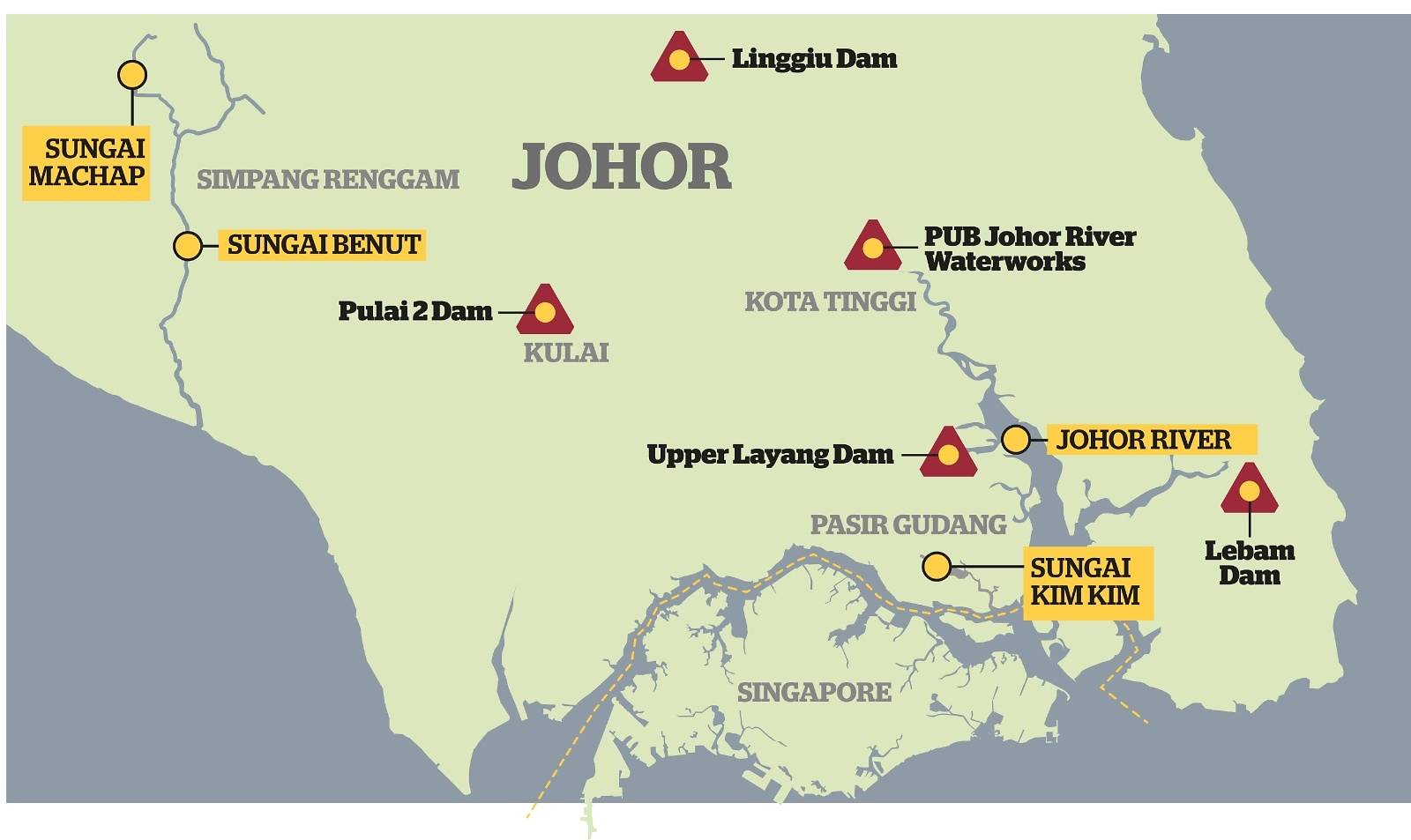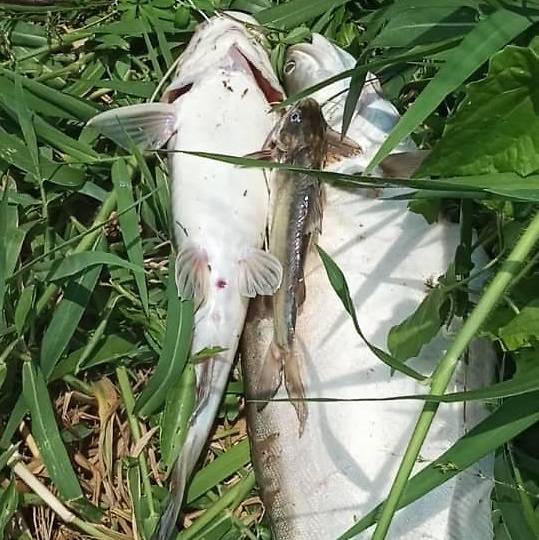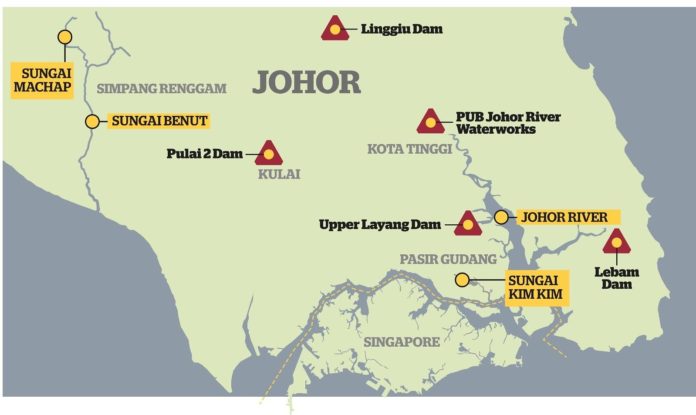SINGAPORE: Over the last two months, the state of Johor has been hit by a series of environmental problems, impacting its rivers and water treatment facilities. This has shone the spotlight on the issue of water sustainability.
The problems have affected thousands of local residents, causing some to fall ill while disrupting water supply to homes.
The water levels at major dams have fallen below the critical mark due to dry weather while some rivers, including the Johor River, have been polluted by chemicals.

The four rivers highlighted here were impacted by pollution while the water levels at the Lebam, Upper Layang and Pulai 2 dams reached critical levels. Singapore’s water supply, which is transferred to PUB’s Johor River Waterworks from the Linggiu Dam, were also affected by pollution in the Johor River. (Illustration: Kenneth Choy)
The federal government and Johor Sultan Ibrahim Iskandar have called for action from the state government to resolve the issues.
The various episodes have also resulted in Singapore raising concerns over water sustainability.
On Apr 9, Prime Minister Lee Hsien Loong said during a joint press conference with his counterpart, Dr Mahathir Mohamad, that Singapore has raised with the Malaysian government its concerns about pollution in the Johor River as well as its long-term yield.
Under the 1962 Water Agreement, Singapore is entitled to draw up to 250 million gallons a day (mgd) of water from the Johor River.
Here’s a breakdown of the environmental issues that have surfaced since March:
THREE DAMS BELOW CRITICAL LEVELS
Last week, the Johor state government announced that three dams, which supply raw water to treatment plants, have fallen below the critical mark due to hot weather.
As of Apr 18, the water levels at the Lebam dam, Upper Layang dam and the Pulai 2 dam were at 15.9 per cent, 21.8 per cent and 36.1 per cent respectively.
The treatment plants serve about one million people, including residents in Kota Tinggi, Tanjung Balau, Teluk Ramunia, Pengarang, Bandar Penawar and Pasir Gudang.
The water level at the Sungai Lebam Dam in Johor as seen on Feb 28, 2019 (left) and Apr 23, 2019. (Photos: Norbakti Alias)
The Johor state government had earlier stated that it will consider cloud seeding in April if the dry spell persists.
Cloud seeding is the induction of rain by introducing chemicals into clouds. Silver iodide or dry ice is dispersed into the clouds to provide nuclei for moisture to condense around.
Water levels at major dams in Johor state are hovering around the critical point, as parts of Malaysia experience a heatwave. (Photo: Bernama)
On Wednesday, Johor International Trade, Investments and Utilities Committee Chairman Jimmy Puah told CNA that the low water level situation at major dams is improving and that things are expected to be back to normal in six weeks when more rain is expected.
PASIR GUDANG CHEMICAL POISONING INCIDENT
Beside hot weather, environmental pollution has also been a problem.
What started out as an isolated incident of illegally dumping chemicals into a Johor river escalated into a wave of chemical poisoning cases, with more than 2,700 people taken ill.
In early March, a tanker lorry believed to be from an illegal tyre recycling factory dumped oil waste and sludge into Sungai Kim Kim in Pasir Gudang.
Thousands later fell ill after breathing in fumes from the toxic chemicals and more than 100 schools were ordered shut as a result. Four people have pleaded not guilty in relation to the case.
READ: Second Singaporean man charged in Pasir Gudang chemical dumping
Initial cleaning works inadvertently worsened the chemical reaction, as the contractor engaged was not experienced in dealing with chemical waste.
Students were hospitalised after breathing in toxic fumes from chemicals illegally dumped in Sungai Kim Kim. (Photo: Bernama)
Subsequently, the federal government allocated RM6.4 million (US$1.56 million) to clean up a 1.5-km stretch of the river.
The crown prince of Johor, Tunku Ismail Sultan Ibrahim, later hit out at the authorities over their handling of the incident.
In a series of tweets, he said: “Since the first day (Mar 7), an emergency should have been declared and residents temporarily evacuated elsewhere, until it was guaranteed safe.”
The federal parliament had debated a motion on whether to declare a state of emergency over the incident, only to later decide against it.
Dr Mahathir told reporters that there was no need to declare an emergency.
AMMONIA POLLUTION
In early April, ammonia pollution in Sungai Sayong disrupted water supply to about 17,000 households in Kulai, a town in southern Johor.
The pollution occurred when a reservoir at a bio-composite centre next to an oil palm mill in Sedenak burst, causing water containing ammonia to flow into Sungai Sayong, which supplies raw water to the Johor River.
Several water treatment plants in the area suspended operations on Apr 3.
On Apr 4, Singapore’s national water agency PUB said its Johor River Waterworks plant halted treatment operations due to the high levels of ammonia in the river. It resumed operations on Apr 6.
On Tuesday, a water treatment plant at Simpang Renggam, near Ayer Hitem, was shut down due to high ammonia content readings, exceeding the level permitted by the Health Ministry.

The Johor Sultan has ordered a probe into river pollution that has killed fish in the waters. (Photo: Johor Royal Press Office)
The ammonia pollution was believed to have occurred as leachate seeped when the embankments of a discharge pond broke due to heavy rain.
On Apr 9, PM Lee said if the Johor River suffers an incident like the recent one at Sungai Kim Kim, the effects “will be disastrous for both countries”.
HOW THIS AFFECTS SINGAPORE
Beside drawing up to 250 mgd of water daily, Singapore is also required to supply Johor with 5 mgd of treated water. However, in practice, Singapore has been supplying 16 mgd of treated water to Johor at its request.
In 1990, PUB and Johor had signed an agreement to construct the Linggiu Dam to increase the yield of the Johor River.
File photo of the Johor River.
Johor owns the Linggiu Dam, but Singapore has paid more than S$300 million for its construction and operational costs, as well as compensation for the land used for the Linggiu Reservoir, the potential loss of revenue from logging activities, and as a one-time payment of the lease of that land for the remaining tenure of the 1962 agreement.
As Mr Lee noted on Apr 9, Johor has built water plants on the Johor River, upstream of PUB’s waterworks at Kota Tinggi. These plants, together with PUB’s Kota Tinggi water works, could possibly draw more water than the river can sustain.
Mr Lee noted that it is in both countries’ interests to work together to ensure sustainable water supply.
There is also a potential environment dimension for Singapore.
At the height of the Sungai Kim Kim incident, there were concerns over how transnational pollution might affect the water quality of fish farms in Singapore.
However, the authorities said no anomalies or fish mortality had been observed at Singapore’s fish farms.





